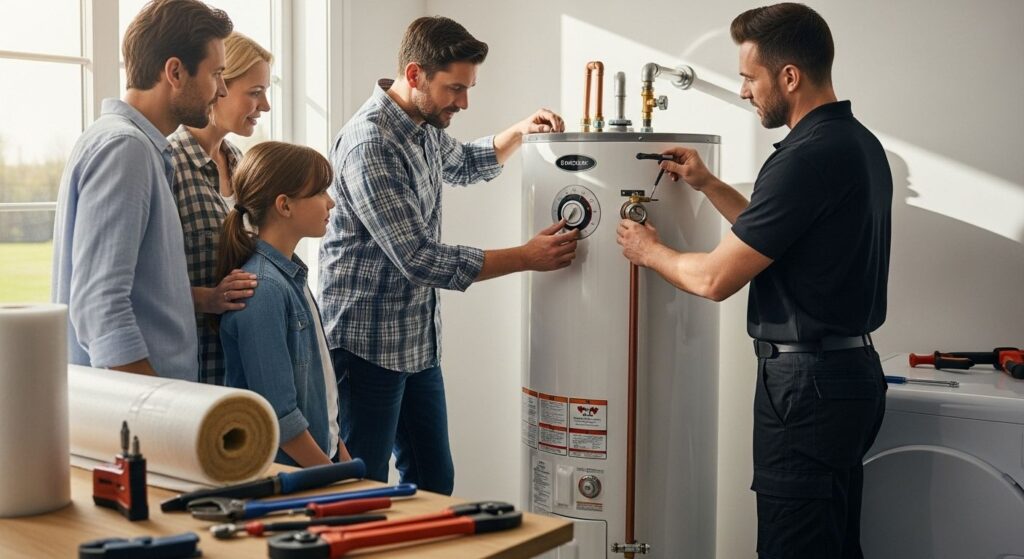Most people set their water heaters and forget about them, assuming hot water will always flow without a hitch. Yet surprises lurk in even the most ordinary tanks. A water heater set just 20 degrees too high can drive up your energy bills and endanger your family. Routine checks and a few simple habits can actually double the lifespan of your water heater while saving hundreds each year.
Table of Contents
- 1: Check The Temperature Setting Regularly
- 2: Flush The Tank To Remove Sediment
- 3: Inspect The Anode Rod Annually
- 4: Test The Pressure Relief Valve
- 5: Insulate Hot Water Pipes
- 6: Schedule Professional Inspections
- 7: Address Leaks Immediately
Quick Summary
| Takeaway | Explanation |
|---|---|
| Regularly check your water heater’s temperature | Set the temperature to 120°F to save energy and reduce scalding risks. |
| Flush the tank annually to remove sediment | Annual flushing keeps your heater efficient and extends its lifespan by removing mineral buildup. |
| Inspect the anode rod every 1-3 years | Checking the anode rod can prevent tank corrosion and prolong your water heater’s life significantly. |
| Test the pressure relief valve yearly | Regular testing ensures this safety mechanism works, preventing dangerous pressure buildup. |
| Address leaks immediately when detected | Promptly fixing leaks can prevent costly water damage and structural issues in your home. |
1: Check the Temperature Setting Regularly
Monitoring and adjusting your water heater’s temperature is a crucial aspect of water heater maintenance that many homeowners overlook. Most residential water heaters come preset at temperatures that are often unnecessarily high, which can lead to increased energy consumption and potential safety risks.
According to the U.S. Department of Energy, the recommended temperature setting is 120°F. This optimal setting provides several significant benefits:
- Reduces energy consumption and lowers utility bills
- Minimizes risk of scalding, especially for children and elderly
- Slows mineral buildup and corrosion in water heater and pipes
To check your water heater’s temperature, locate the temperature dial typically found on the side of the tank. Many homeowners discover their water heaters are set much higher than necessary, sometimes reaching up to 140°F. By simply turning the dial to 120°F, you can achieve substantial energy savings without compromising hot water quality.
Regular temperature checks become even more critical if you experience any of these signs:
- Inconsistent water temperature
- Unusually high energy bills
- Visible sediment in hot water
When adjusting the temperature, always exercise caution. Turn off the power to the water heater at the circuit breaker before making any modifications. If you’re uncomfortable performing this task, consider consulting a professional plumber who can safely adjust the settings and provide additional maintenance recommendations.
Remember that temperature settings can vary slightly depending on your specific water heater model and household needs. Families with young children or elderly residents might prefer a slightly lower temperature for added safety, while households with high hot water demands might require minor adjustments.
2: Flush the Tank to Remove Sediment
Sediment buildup is a silent destroyer of water heater efficiency and longevity. Over time, minerals like calcium and magnesium naturally accumulate at the bottom of your water heater tank, creating a layer of debris that can significantly reduce your system’s performance and lifespan.
According to the City of Portland, most manufacturers recommend flushing your water heater annually to prevent potential issues. This maintenance task helps prevent problems such as:
- Reduced heating efficiency
- Increased energy consumption
- Potential tank corrosion
- Rust-colored water
- Unexplained noise from the tank
Annual flushing is crucial for maintaining your water heater’s optimal performance. The process involves draining the tank completely to remove accumulated sediment, which can act as an insulating layer between the water and the heating element. This sediment layer forces your water heater to work harder, consuming more energy and potentially shortening its operational life.
To perform a basic tank flush, you’ll need a garden hose and some basic tools. Turn off the power or gas supply to the water heater, connect the hose to the drain valve, and let the water flow until it runs clear. This simple maintenance step can save you significant money on repairs and energy costs.
Our expert plumbing guide offers more detailed insights into water heater maintenance for homeowners who want to ensure their system runs smoothly. While some homeowners feel comfortable performing this task, others might prefer professional assistance to guarantee a thorough and safe sediment removal process.
Remember that water heater maintenance is not just about preventing problems it’s about ensuring consistent hot water supply, energy efficiency, and extending the life of your valuable home appliance.
3: Inspect the Anode Rod Annually
The anode rod is perhaps the most underappreciated component of your water heater, acting as a critical sacrificial element that protects your tank from corrosion. This metallic rod, typically made of magnesium or aluminum, attracts corrosive elements in the water, essentially sacrificing itself to prevent your water heater tank from rusting.
Most water heater manufacturers recommend inspecting the anode rod every one to three years. The rod’s condition directly impacts the longevity of your water heater tank. When the anode rod becomes severely corroded, your tank becomes vulnerable to rapid deterioration, which can lead to expensive replacements.
Key signs that indicate your anode rod needs immediate attention include:
- Significant corrosion covering more than 50% of the rod
- Exposed steel core of the rod
- Calcium deposits or scaling around the rod
- Reduced thickness of the rod (less than half its original diameter)
To inspect the anode rod, you’ll need to:
- Turn off the water heater’s power or gas supply
- Shut off the cold water inlet valve
- Drain a few gallons of water from the tank
- Locate and remove the anode rod (typically found at the top of the tank)
- Visually inspect the rod’s condition
While some homeowners are comfortable performing this inspection, our professional plumbing services can provide a comprehensive evaluation and replacement if needed. Professional inspection ensures that not only the anode rod but the entire water heater system is functioning optimally.
Replacing the anode rod is considerably less expensive than replacing an entire water heater tank. Think of it as a small investment that can potentially save you hundreds or even thousands of dollars in future repair or replacement costs. Regular maintenance of this seemingly simple component can extend your water heater’s life by several years, making it a crucial aspect of responsible home ownership.
4: Test the Pressure Relief Valve
The pressure relief valve is a critical safety mechanism in your water heater that prevents potentially catastrophic tank explosions by releasing excess pressure. This small but mighty component acts as a guardian, protecting your home from dangerous pressure buildup that could lead to significant damage or injury.
According to the American Society of Home Inspectors, regular testing of this valve is essential for maintaining your water heater’s safety and functionality. A malfunctioning pressure relief valve can transform your water heater from a household appliance into a serious safety hazard.
Warning signs that indicate potential pressure relief valve issues include:
- Visible corrosion or rust around the valve
- Water leaking from the valve even when not activated
- Strange noises or hissing sounds near the valve
- Inability to release pressure during testing
To test the pressure relief valve, follow these steps:
- Ensure the area around the valve is clear
- Place a bucket beneath the discharge pipe
- Lift the valve’s lever carefully
- Listen for a rush of air or water
- Observe if the valve opens and closes smoothly
Caution is paramount during this process. If water continues to flow after releasing the lever or if you notice any irregularities, immediate professional intervention is necessary. Our expert plumbing team can provide a comprehensive valve inspection and replacement if required.
Homeowners should perform this test annually, preferably when the water heater is cool. Remember that a functioning pressure relief valve is not just a maintenance task it’s a critical safety measure that protects your home and family from potential water heater failures. If you’re uncertain about performing this test or notice any issues, always consult a professional plumber to ensure your water heater operates safely and efficiently.
5: Insulate Hot Water Pipes
Pipe insulation is a critical yet often overlooked aspect of water heater maintenance that can significantly improve your home’s energy efficiency and reduce utility costs. Uninsulated hot water pipes lose heat rapidly, causing your water heater to work harder and consume more energy to maintain desired water temperatures.
According to the U.S. Department of Energy, insulating hot water pipes is a key strategy to reduce water heating bills, which can account for approximately 18% of a home’s total energy expenditure. By implementing proper pipe insulation, homeowners can experience multiple benefits:
- Reduced heat loss during water transportation
- Lower energy consumption
- Faster hot water delivery
- Decreased utility costs
- Extended water heater lifespan
When selecting pipe insulation materials, consider these essential factors:
- Foam pipe sleeves are cost-effective and easy to install
- Fiberglass insulation offers superior thermal resistance
- Self-sealing insulation provides quick and secure coverage
- Materials should be appropriate for your specific pipe configuration
Our comprehensive guide to pipe insulation offers detailed insights into selecting and installing the right insulation for your home. While some homeowners might feel comfortable completing this project independently, professional installation ensures optimal coverage and maximum energy efficiency.
Pipe insulation is particularly crucial in colder regions like Ottawa, where temperature fluctuations can impact water heating performance. Properly insulated pipes not only conserve energy but also protect against potential freezing and associated damage during winter months. By investing a modest amount in pipe insulation, homeowners can realize significant long-term savings and improve their water heating system’s overall performance.
6: Schedule Professional Inspections
Professional water heater inspections are far more than a mere maintenance suggestion they are a critical investment in your home’s safety and efficiency. Trained professionals can detect potential issues that might go unnoticed by the untrained eye, preventing costly repairs and potential catastrophic failures.
According to the Maryland Department of Labor, homeowners should schedule external water heater inspections every two years to ensure safe operation and compliance with safety standards. These comprehensive evaluations go beyond simple visual assessments, providing in-depth analysis of your water heating system.
Key aspects of a professional water heater inspection include:
- Comprehensive system diagnostics
- Pressure and temperature valve testing
- Corrosion and sediment buildup assessment
- Electrical and gas connection evaluations
- Identification of potential safety hazards
Benefits of regular professional inspections encompass:
- Early detection of potential system failures
- Extended water heater lifespan
- Improved energy efficiency
- Reduced risk of unexpected breakdowns
- Maintenance of manufacturer’s warranty requirements
Learn how to select the right plumbing professional to ensure your water heater receives top-quality care. While some homeowners might view professional inspections as an unnecessary expense, they are actually a strategic approach to preventing more significant and expensive problems in the future.
Think of a professional water heater inspection like a medical checkup for your home’s critical infrastructure. Just as you wouldn’t skip regular health screenings, you shouldn’t neglect your water heater’s periodic professional evaluation. These inspections not only protect your investment but also provide peace of mind, knowing that your home’s hot water system is functioning safely and efficiently.
7: Address Leaks Immediately
Water heater leaks are not just inconvenient they can quickly escalate into costly home disasters if left unaddressed. Small drips can transform into major structural damage, potentially compromising your home’s foundation, electrical systems, and surrounding infrastructure.
According to the U.S. Environmental Protection Agency, prompt leak detection and repair are crucial for preventing extensive water waste and property damage. Understanding the potential sources and implications of water heater leaks is the first step in protecting your home.
Common leak locations and their potential risks include:
- Tank bottom connections
- Pressure relief valve area
- Pipe inlet and outlet connections
- Corrosion points on the tank exterior
- Loose or damaged fittings
Warning signs that demand immediate attention:
- Water pooling around the water heater base
- Rust-colored water or visible corrosion
- Unexplained increase in water bills
- Musty odors near the water heater
- Visible moisture or water stains on surrounding walls
Our emergency plumbing repair guide offers critical insights for homeowners facing potential water heater emergencies. While some minor leaks might seem insignificant, they can rapidly progress into major structural issues that require extensive and expensive repairs.
Professional intervention becomes crucial when you notice persistent or growing leaks. Experienced plumbers can diagnose the root cause, whether it’s a failing tank, deteriorating connections, or internal corrosion. Remember that water heater leaks are rarely self-resolving and will only worsen with time. The moment you detect any signs of leakage, consider it a priority maintenance issue that requires immediate professional assessment to prevent potential catastrophic home damage.
Protect Your Ottawa Home With Expert Water Heater Maintenance
Keeping your water heater in top condition can feel overwhelming, especially when mineral buildup, inconsistent temperatures, or unexpected leaks suddenly disrupt your daily routine. You want peace of mind knowing your system is efficient, safe, and ready to deliver hot water whenever you need it. This is where the real value of professional support shines—routine care and emergency help from trusted local experts make all the difference. Discover why so many Ottawa homeowners rely on Delta Plumbers for ongoing maintenance, annual inspections, and urgent repairs designed to extend your water heater’s life and keep your home worry-free.

Let our experienced team handle everything from flushing your tank and inspecting the anode rod to testing crucial safety valves and fixing leaks the moment they appear. Avoid unexpected breakdowns and save on costly replacements later by partnering with knowledgeable professionals who put your comfort first. Visit Delta Plumbers Ottawa now to schedule your maintenance service or request an emergency call-out. Your reliable hot water supply starts with the right care—contact us today to experience the difference!
Below is a comprehensive table summarizing the core water heater maintenance tips, steps, and benefits covered throughout the article for easy reference and practical application.
| Maintenance Tip | Key Actions | Main Benefits & Outcomes |
|---|---|---|
| Check Temperature Setting Regularly | Set to 120°F; check every few months | Saves energy, lowers bills, reduces scalding risk |
| Flush Tank to Remove Sediment | Drain hot water tank annually | Maintains efficiency, prevents corrosion, extends appliance lifespan |
| Inspect Anode Rod Annually | Check rod for corrosion or thinning every 1-3 years | Prevents tank rust, avoids costly replacements, prolongs system life |
| Test Pressure Relief Valve | Annually test for proper function and leakage | Prevents dangerous pressure build-up and ensures system safety |
| Insulate Hot Water Pipes | Use foam, fibreglass or self-sealing pipe insulation | Reduces heat loss, cuts energy costs, speeds hot water delivery |
| Schedule Professional Inspections | Book every 2 years with a trusted plumber | Detects hidden issues, maintains warranty, prevents major breakdowns |
| Address Leaks Immediately | Investigate and repair any visible leaks at once | Prevents water damage, structural harm, and expensive repairs |
Frequently Asked Questions
How often should I check the temperature setting of my water heater?
You should check the temperature setting of your water heater regularly, ideally every few months. The recommended temperature is 120°F to ensure safety and energy efficiency.
What are the signs that my water heater needs to be flushed?
Signs that your water heater needs to be flushed include reduced heating efficiency, increased energy bills, visible rust-colored water, and unexplained noise from the tank.
Why is inspecting the anode rod important for my water heater?
Inspecting the anode rod is crucial because it protects your water heater tank from corrosion. A corroded anode rod can lead to rapid deterioration of the tank, resulting in costly repairs or replacements.
How can I tell if my water heater’s pressure relief valve is working properly?
You can test the pressure relief valve by lifting its lever to see if it releases water or air. If it does not open smoothly or continues to leak after testing, it may need replacement. Regular testing is recommended annually.









